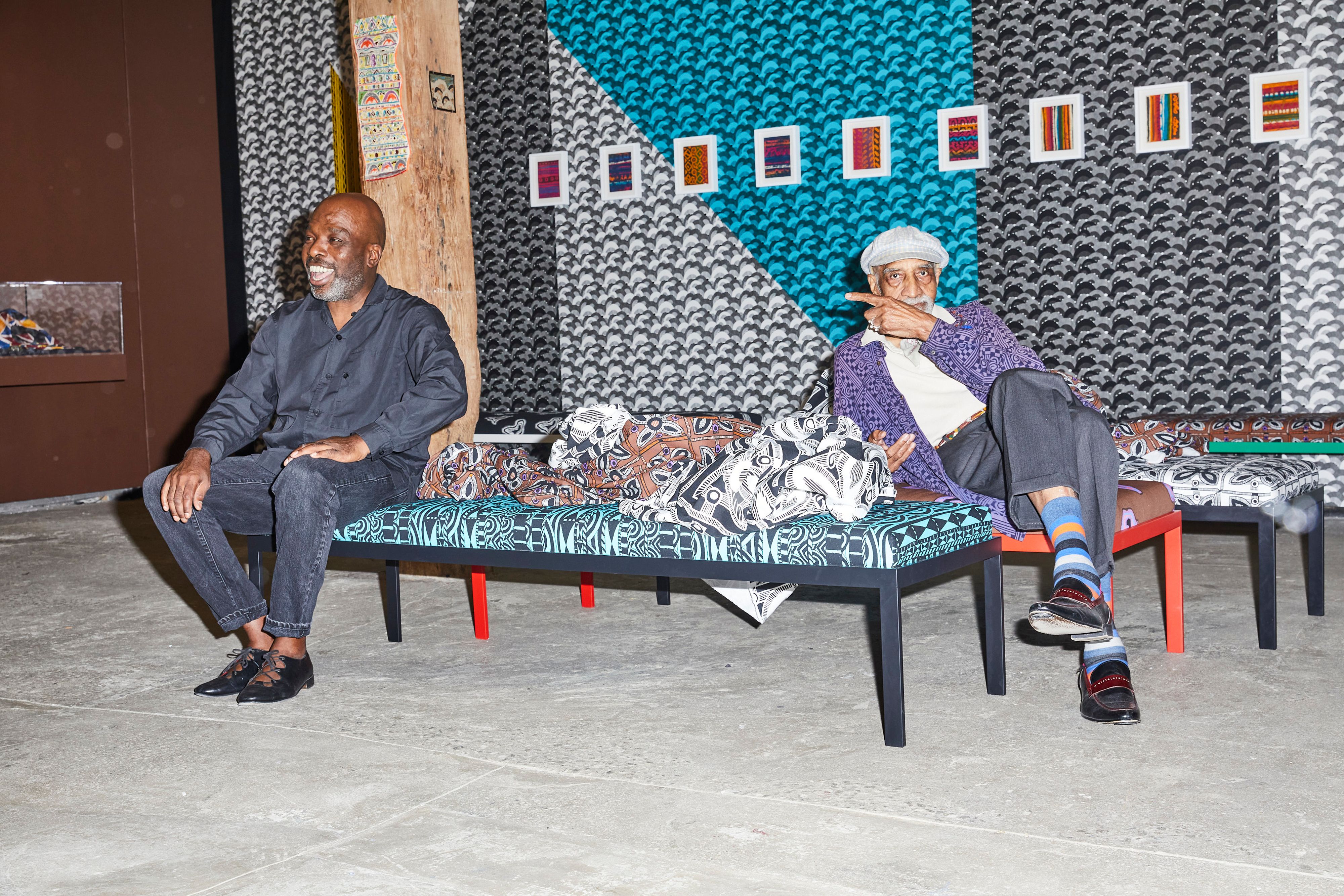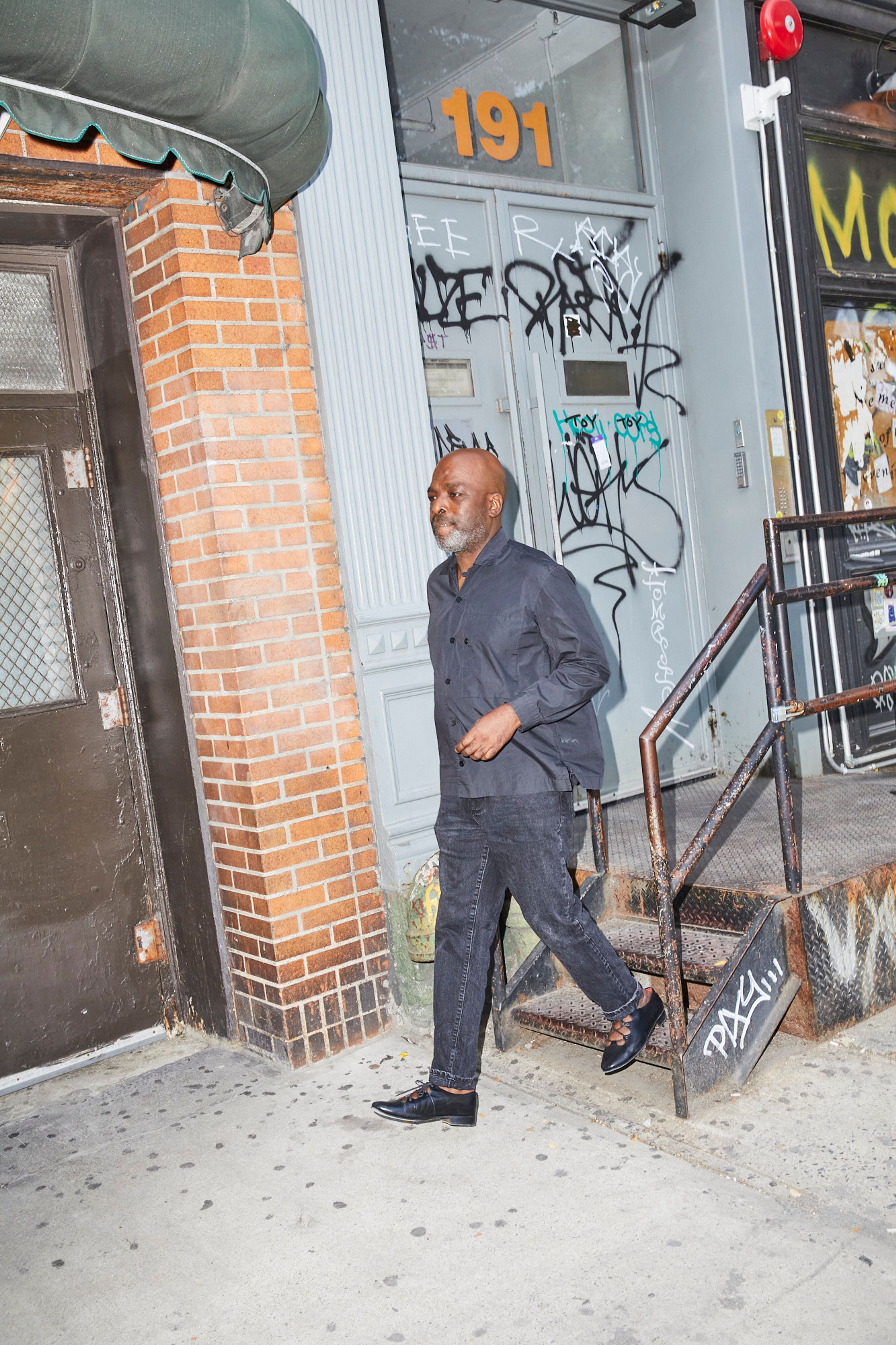DURO OLOWU ON FEAR, THE UNCANNY, AND PATTERN AS AN EQUALIZER
by Emmanuel Olunkwa
Duro Olowu and Robert Paige photographed by Jeremy Liebman for PIN–UP 33.
Nigerian-born British fashion designer Duro Olowu is one of the few people whose garments have spawned a new term in the fashion lexicon: the “Duro dress,” as it’s called, has an empire waist with multiple prints that he pulls from a variety of global sources — one season it’s the West African masquerades he grew up with in Nigeria, another it’s Picasso’s paintings. You’ve seen the dress on the likes of Michelle Obama and Thelma Golden, director and chief curator at The Studio Museum in Harlem, to whom Olowu has been married since 2008. In recent years, Olowu has turned his keen eye for patterns towards curation, starting with Material (2012) at Salon94, a mix of limited-edition Olowu originals and textiles, furniture, photography and found objects, and Duro Olowu: Seeing Chicago (2020) at the Windy City’s Museum of Contemporary Art, the first time a non-art professional guest curated in the institution’s 50-year history. His most recent curatorial project was Robert Earl Paige: Power to the People at Salon94 (2022), the first New York solo exhibition of the Chicago artist who introduced West African-inspired textiles to American shoppers in the 1970s. The exhibit pulls together Paige’s fabric work alongside his ceramics, collages and etchings.
Emmanuel Olunkwa: Robert Paige and I were talking about the Harlem Renaissance, and he mentioned how it was a label assigned to the work Black people produced at the time and not one we gave ourselves.
Duro Olowu: Exactly! It becomes a question of who gets to dictate history. It’s not useful when you pin something new to a certain period in time. It becomes a conversation about how people ascribe narratives to art based on cultures they don’t understand, be it African Americans, women, or minority artists. Collectives are always much more attractive to institutions because you can just group everyone together, regardless of the artists’ specific visions.
When did you first meet Robert?
In Chicago during the Museum of Contemporary Art show I curated. He asked Romi Crawford, a professor at the Art Institute of Chicago, to introduce us. We had a few conversations, and there was something about him that stuck with me. All great artists have a certain relationship with clothing that says a lot about them — it shows you what they’re thinking, even beyond the work they make. I told him I’d come by his place for a coffee one day, and when I walked in his corridor there was a corkboard with very powerful collages made from fabrics and other found objects. He had a beautiful one in particular of newspaper and magazine cuttings from various things that happened in Chicago, of people who were killed in the 70s by police. It looked like the sort of piece that would be on display at the Whitney Biennial. And when you looked closely, it was a very potent rendition of a lynching. I didn’t even see any fabrics until I went into the main room. I think he had it just to remind himself every day of why he does the work he does. Robert doesn’t realize his depth. He reads everything, not out of fear, but out of curiosity. He wants to know where his destiny lies.
Why was pattern your entry point into design?
My real visual training came from a juxtaposition of color and pattern. I came to recognize that there had to be a uniformity. I’d gravitate towards a color like the indigo of the Urhobo African fabrics from which my mother made dresses. My aunts and uncles wore them. And then I’d be in London and someone would be wearing a kimono with the same shade of indigo, and I’d think, “How’d this spill over?” Pattern is politics. It’s not specific to countries — it’s an equalizer.
Would you say you speak to how your family uses color when they make these garments?
Color helps to create identity and a shared sensibility — people have certain uniforms they wear that place them in a particular group. And then there are ways people dress without realizing it, creating something for us to gaze at, those people your eyes follow as they leave the room because they have such a presence. It’s like when you’re a kid and you put patches on your flares — you do that to stand apart from everyone else. Once I got my practice going, I decided I would only do things that felt instinctual.
What were the rules you gave yourself?
The first thing was, if I don’t find it interesting, why should anyone else? [Laughs.] If it’s your work and you’re putting yourself out there, then you should care about it. The second thing was a focus on high-quality materials, even if what you’re using is simple.

Duro Olowu by Jeremy Liebman for PIN–UP 33.
Do you feel like your work represents your culture?
I don’t think you can avoid that in your work, because you don’t understand who you are unless you know where you came from. Whether you’re Cristóbal Balenciaga or Yves Saint Laurent, or a star designer in the Congo in the 1970s, the heart of the matter is the cosmopolitan nature of design.
What are you trying to communicate through your designs?
The first thing I want to communicate is a kind of familiarity that you didn’t know you had. That’s the most endearing and empathetic way to look at design and art. And the other thing I prioritize is having great relationships with the artists, and showing the process of their work.
It’s about finding a rhythm. In writing, designing, art-making, it’s all about context, but the process for most of these forms has the same starting point.
When people call Tupac Shakur the greatest rapper, I feel like that doesn’t say enough — he was more than just a rapper. There was an art to his music and composition style. As recently as ten years ago, hip-hop videos felt like art films. But then that whole aesthetic was co-opted so many times it started to lose its meaning.
I’m really grateful for the people who have built worlds with their art practices, who wake up every day with a certain conviction to keep going and improve their craft.
But maybe they wake up with fear. It’s tough when your presence becomes bigger than your work. I’m not saying it’s the most terrible thing, because if you can pay your rent, then you have a good life. But fame is not the way forward. No one wants to enlighten you. Instead, everyone is waiting for you to say something meaningful.